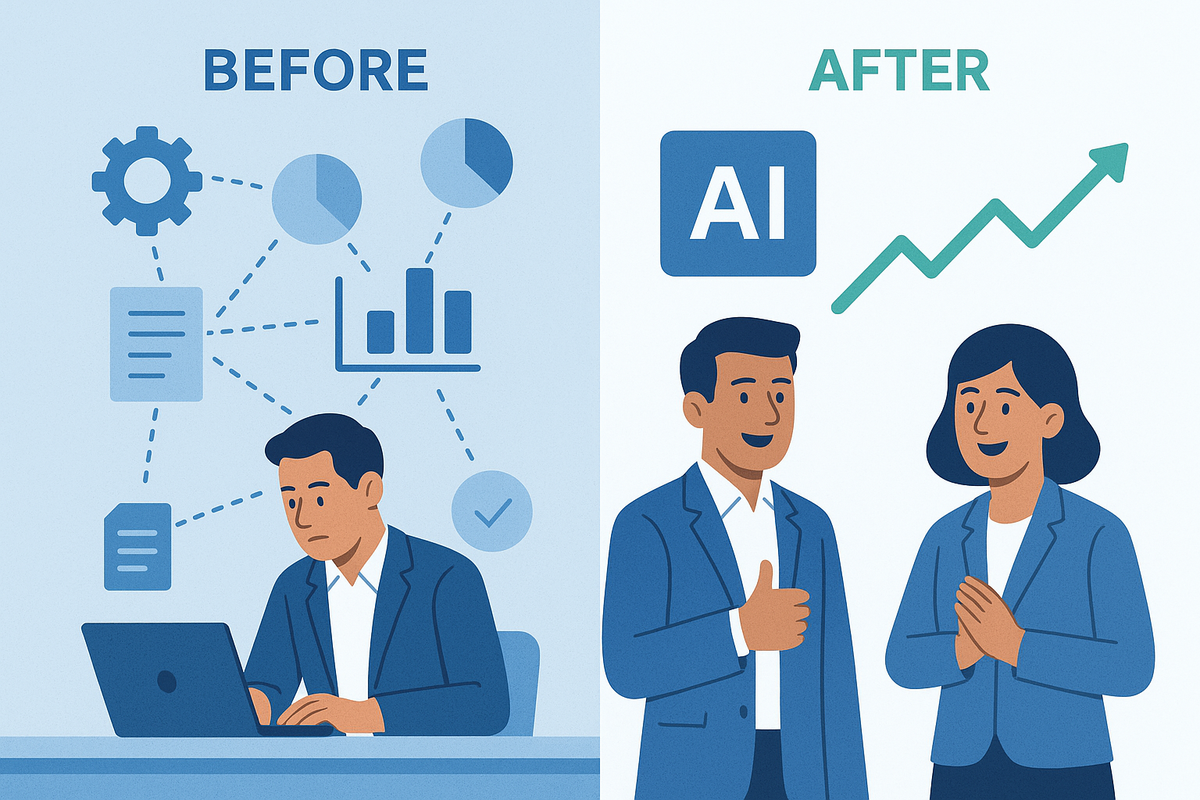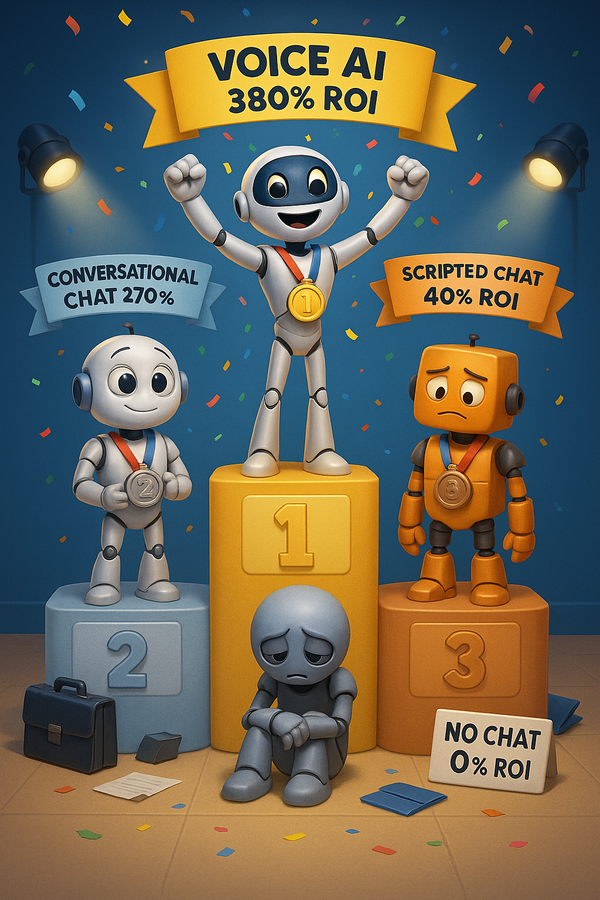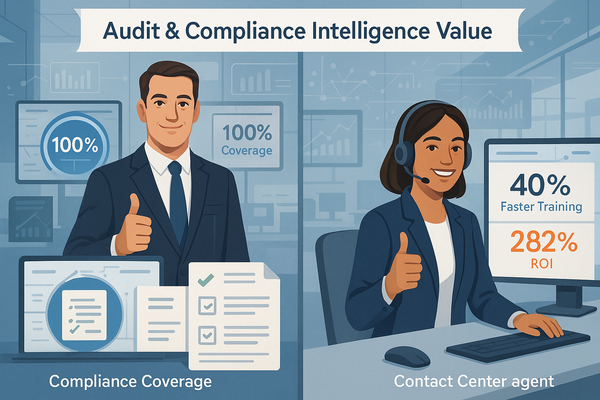Enterprise AI Platform Implementation Success: Proven Strategies for Optimal ROI

🎯 Executive Summary: Enterprise AI platform deployments are delivering measurable results when implemented strategically. Five9 reports 100% AI attach rates on million-dollar deals, while 74% of organizations say their advanced AI initiatives meet or exceed ROI expectations. However, successful deployments require careful platform selection, realistic cost planning, and proper data preparation. Here's your practical guide to maximizing enterprise AI platform value while avoiding common implementation pitfalls.
📈 The Enterprise AI Platform Success Story
The 2025 enterprise AI vendor landscape shows strong momentum when deployments are done right:
Platform Success Indicators:
- Five9 achieved 32% enterprise AI revenue growth with "virtually all new customer deals exceeding $1 million in Annual Recurring Revenue (ARR) included AI solutions"
- Genesys reports "AI represented more than 10% of Genesys Cloud bookings" during their first half 2025
- Leading platforms NICE CXone (8.45), Five9 (8.40), and Genesys Cloud CX (8.36) consistently score in the "Excellent" range across critical enterprise deployment dimensions
Independent Validation:
- 74% of organizations report their most advanced AI initiatives are "meeting or exceeding ROI expectations"
- Companies are averaging "$3.50 in value for every $1 spent on AI" according to Microsoft IDC studies
- 90% of initiatives deliver measurable returns within 18 months when properly scoped
🛠️ Platform Implementation Success Framework
When Enterprise Platforms Excel
Ideal Platform Use Cases:
- High-Volume, Standardized Processes: Customer service inquiries, appointment scheduling, billing support
- Regulated Industries: Financial services, healthcare where compliance and audit trails are critical
- Rapid Deployment Needs: Organizations requiring AI capabilities within 3-6 months
- Limited Internal AI Expertise: Teams without dedicated data science or ML engineering resources
Platform Value Drivers:
- Pre-built industry templates and workflows
- Integrated compliance and security frameworks
- Vendor-managed model updates and maintenance
- Comprehensive support and training programs
Multi-Vendor Strategy Success Patterns
The 37% Rule: 37% of enterprises now use "5 or more models" compared to 29% last year - not because platforms fail, but because different AI models excel at different tasks.
Successful Multi-Vendor Orchestration:
- Contact Center Foundation: Start with primary platform (NICE, Genesys, Five9) for core customer service
- Specialized Enhancement: Add direct foundation model APIs for specific use cases requiring cutting-edge capabilities
- Cost Optimization: Use platform for high-touch, mission-critical operations; direct APIs for experimentation and specialized tasks
💡 Avoiding Common Implementation Traps
Data Quality Preparation: The 30% Success Factor
Gartner notes that "30% of GenAI projects fail because of poor data quality" - but this is preventable with proper preparation.
Root Causes of Data Quality Issues:
- Format Incompatibility: Most organizations have "plenty of data – stored in lakes, warehouses, internal tools – but not in a format that's usable for training"
- Insufficient Context: Data exists but lacks the metadata and context needed for AI model training
- Measurement Framework Gaps: Unclear success metrics make it impossible to validate AI performance
- Governance Blind Spots: "Nearly two-thirds (64%) of organizations lack full visibility into their AI risks"
Data Success Preparation Checklist:
- Audit Data Accessibility (Week 1): Inventory what data exists and in what formats
- Define Success Metrics (Week 2): Establish clear, measurable outcomes before platform selection
- Clean Sample Datasets (Month 1): Start with small, high-quality datasets rather than comprehensive data overhaul
- Establish Governance Framework (Month 2): Implement data usage policies and security controls
Cost Planning: The 3-Year View
Platform Cost Structure Reality:
- Subscription Fees: Salesforce Agentforce starts at $125 per user/month; Microsoft Copilot adds $30 per user/month
- Implementation Services: Range from $2,500 to $15,000 for basic deployments, $300K-$2.9M for comprehensive implementations
- Ongoing Optimization: Budget 20-40 hours per month for maintenance and tuning
Cost Optimization Strategies:
- Phased Deployment: Start with specific use cases before expanding platform-wide
- Hybrid Approach: Use platforms for core functions, direct APIs for specialized needs
- Reserved Capacity: Azure offers "up to 42% cost reduction with 3-year commitments"
- Usage Monitoring: Implement cost tracking to avoid surprise charges from usage-based pricing
Skills Gap Bridge: The Implementation Accelerator
"Resistance to adopting GenAI solutions slowed project timelines" typically stems from "unfamiliarity with the technologies or from skill and technical gaps."
Success Acceleration Tactics:
- Platform-Specific Training: Leverage vendor training programs and certification paths
- Change Management Investment: Budget for user adoption programs, not just technology
- Pilot Program Approach: Start with enthusiastic early adopters before organization-wide rollout
- External Expertise: Consider implementation partners for complex deployments
🎯 Platform Selection Decision Framework
Enterprise Platform vs. Direct Implementation Matrix
|
Factor |
Enterprise Platform Best |
Direct API/Multi-Vendor Best |
|
Timeline |
Need results in 3-6 months |
Can invest 6-12 months in custom
development |
|
Compliance |
Regulated industries requiring audit
trails |
Flexible compliance requirements |
|
Team Expertise |
Limited AI/ML internal capabilities |
Strong technical team with AI
experience |
|
Use Case Scope |
Standardized, high-volume processes |
Cutting-edge, experimental
applications |
|
Budget Model |
Predictable subscription costs
preferred |
Variable costs acceptable for
flexibility |
Vendor Evaluation Best Practices
Due Diligence Framework:
- Reference Customer Validation: Request 3+ references from similar-sized organizations in your industry
- Technical Architecture Review: Understand underlying AI models and integration capabilities
- Cost Transparency: Get detailed pricing for all components including implementation, training, and ongoing support
- Security and Compliance Verification: Validate specific regulatory requirements for your industry
Red Flag Warning Signs:
- Vendors who can't explain their underlying AI model strategy
- Pricing that seems too good to be true (often indicates hidden costs)
- References only from much smaller or different industry organizations
- Pressure for immediate commitment without proper evaluation period
📊 ROI Optimization Strategies
Maximizing Platform Value
Quick Wins Strategy (Month 1-3):
- Focus on "small number of high-impact use cases in proven areas"
- Layer AI capabilities "on top of existing processes" rather than replacing entire workflows
- Start with high-volume, low-complexity tasks like password resets and balance inquiries
Scale-Up Success (Month 4-12):
- Expand to adjacent use cases once initial deployment proves successful
- Implement feedback loops to continuously improve AI performance
- Build organizational confidence through demonstrated, measurable results
Multi-Vendor Optimization
Strategic Vendor Portfolio:
- Primary Platform: Choose one enterprise platform as your foundation (contact center, productivity, etc.)
- Specialized Vendors: Add direct foundation model access for specific high-value applications
- Innovation Testing: Reserve budget for experimenting with emerging AI capabilities
Cost Management Across Vendors:
- Implement unified monitoring across all AI spending
- Negotiate volume discounts based on total AI usage across platforms
- Regular vendor performance reviews to optimize platform mix
🚀 Implementation Roadmap for Success
Phase 1: Foundation (Months 1-3)
- Platform Selection: Choose primary enterprise platform based on core business needs
- Data Preparation: Clean and structure data for initial use cases
- Team Training: Invest in platform-specific training and change management
- Pilot Deployment: Launch with limited scope, high-impact use case
Phase 2: Expansion (Months 4-8)
- Performance Optimization: Fine-tune initial deployment based on real usage data
- Use Case Expansion: Add adjacent applications once primary use case is stable
- Multi-Vendor Integration: Evaluate adding specialized AI capabilities for specific needs
- Governance Maturity: Implement comprehensive AI governance and monitoring
Phase 3: Scale & Innovation (Months 9-18)
- Organization-Wide Deployment: Roll out proven use cases across departments
- Advanced Capabilities: Explore cutting-edge AI features and experimental applications
- Vendor Portfolio Optimization: Fine-tune mix of platform vs. direct vendor relationships
- Continuous Improvement: Establish ongoing optimization and innovation processes
💼 What This Means for Your AI Strategy
The Balanced Approach Advantage
The most successful enterprises aren't choosing between platforms and direct implementation - they're strategically combining both approaches:
- Platform-First for Core Operations: Use enterprise platforms for mission-critical, high-volume applications where reliability and support are paramount
- Direct APIs for Innovation: Leverage foundation model APIs directly for experimental applications and cutting-edge capabilities
- Vendor Portfolio Management: Maintain relationships with multiple AI vendors to avoid lock-in and optimize costs
Success Metrics That Matter
Focus on Business Outcomes:
- Task completion rates above 85% for defined use cases
- Customer satisfaction scores of 4.0/5.0 or higher
- Measurable cost reduction or revenue increase within 6 months
- User adoption rates exceeding 70% within first year
The Competitive Advantage Window
"Your company's AI success will be as much about vision as adoption." The organizations that succeed will be those that:
- Choose Platforms Strategically: Based on specific business needs rather than vendor marketing
- Prepare Data Systematically: Address the root causes of the 30% failure rate
- Implement Incrementally: Start small, prove value, then scale with confidence
- Optimize Continuously: Regular vendor performance reviews and cost optimization
The opportunity is clear: Enterprise AI platforms are delivering real value when implemented with proper planning, realistic expectations, and strategic vendor portfolio management. The 74% of organizations exceeding ROI expectations are those that treat AI platform adoption as a business transformation initiative, not just a technology purchase.
📝 Note for SMB/Mid-Market: While this analysis focuses on enterprise platforms, the same strategic principles apply to smaller organizations. The key is matching platform sophistication to actual business needs and growth trajectory - often a focused, cost-effective solution delivers better ROI than enterprise-grade platforms for smaller use cases.
Sources and References:
[1] Five9 Q1 2025 slides: Enterprise AI revenue surges 32% as margins expand, Investing.com, May 1, 2025
[2] 2025 Geek Gauge CCaaS Platform Rankings: AI-Powered Analysis Report, OttoQA, May 16, 2025
[3] State of Generative AI in the Enterprise 2024, Deloitte US, 2024
[4] How 100 Enterprise CIOs Are Building and Buying Gen AI in 2025, Andreessen Horowitz, June 2025
[5] Enterprise AI: Complete Overview 2025, SuperAnnotate, May 21, 2025
[6] AI Pricing: What's the True AI Cost for Businesses in 2025?, Zylo, 2025
[7] New Study Reveals Major Gap Between Enterprise AI Adoption and Security Readiness, BigID, June 4, 2025
[8] 2025 AI Business Predictions, PwC, 2025
[9] Budgeting for Large-Scale AI Agent Deployments: 2025 Cost Benchmarks, Markaicode, March 21, 2025
[10] AI in the workplace: A report for 2025, McKinsey, January 28, 2025



